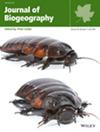Biogeography of Therorhodion in Northeast Asia and Western North America Emphasising Their Past and Future Expansion
Abstract
Aim
To assess the origin, biogeographic history of three Therorhodion species in the Pacific region; to reveal the differentiation within T. camtschaticum across its range from Beringia to Japan; and to discuss the role of Beringia as a refugium in the past and the future.
Location
Northeast Asia and Western North America.
Methods
We analysed 122 original specimens of three species (T. redowskianum, T. glandulosum and T. camtschaticum) from Russia, China, the United States and 43 GenBank accessions from Japan, using seven nuclear loci. We use different approaches to infer genetic structure, divergence time estimations, ancestral area reconstructions and species distribution modelling to better understand the history of the mountain flora in the Pacific region.
Results
Three genetic clusters with an origin in northeast Asia corresponding to the three species were distinguished. The divergence time between T. redowskianum and the other two species was estimated at 19.2 Mya and between T. glandulosum and T. camtschaticum was estimated at 2.13 Mya. Within T. glandulosum and T. camtschaticum, no Western or Eastern Beringian clades were recovered. At the same time, two subclusters were inferred within T. camtschaticum, one including populations from Kamchatka, the Aleutian Isl., the Kuril Isl. and partly Japan, and a second one including other populations from Japan, Sakhalin and Khabarovsk, which were identified with a divergence time estimation at 228 Ka BP. Species distribution modelling revealed that the global distribution area during the LGM remained relatively stable for all three taxa, although we observed some local geographical contractions. In contrast, global range contractions for the three species were predicted for the LIG and future climatic changes in 2061–2080.
Main Conclusions
We show that Therorhodion originated in northeast Asia and diverged during the cooling of the late Miocene, with further diversification and dispersal across the Bering land bridge during the late Pliocene-Pleistocene. Although previous studies found no obvious signs of hybridisation between species in their range overlaps, we revealed traces of some genetic contribution of T. glandulosum in T. camtschaticum populations in Khabarovsk Krai. This study highlights the significance of the including samples from entire range of a species and using different types of markers for adequate biogeographic inferences. It also supports the role of Beringia as a refugium for arctic flora not only in the past, but also into the future.

 求助内容:
求助内容: 应助结果提醒方式:
应助结果提醒方式:


